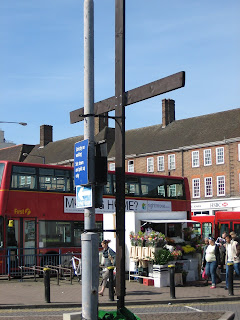High Barnet, the terminus, sets the tone for the whole of the branch: unassuming, leafy, serene.
10 miles from Charing Cross and teetering on the edge of Hertfordshire, the building dates back to 1872 when it was the last stop on a line that ran from Finsbury Park to Edgware via Highgate. You're in no doubt you've come to the end of the line.
The otherwise simple business of leaving the station to head south is defiantly confusing. While I was there, three trains sat for ages at different platforms with their doors open. Fortunately I gambled correctly and selected the one that left first. Others did not. I suspect all termini tend to operate in a similar fashion.
The line sweeps down the valley of the Dollis Brook with pretty spectacular views across the surrounding countryside. Totteridge & Whetstone station looks and feels like a village corner shop.
Woodside Park is even more pastoral, with trees, flowerbeds and greenery lining both platforms, and a large piece of ground outside once used for storing coal.
Like its predecessors it was established in 1872, deep in rural Middlesex, and has its entrance at the end of a deafeningly quiet cul-de-sac. Walking into West Finchley, meanwhile, is like entering a scout hut or oversized garden shed.
Apparently it's one of the least used stations on the whole line. Built in 1933, it's still got ancient signage a-plenty.
Finchley Central is a much grander affair, and even older, dating back to 1867.
There's another entrance behind this one, up above the other side of the tracks, which, amusingly - or frustratingly depending on your circumstances - seems to require you to cross back over the lines and go through the ticket barriers (from the wrong side) to get to any ticket machines.
The whole station also resembles the deck of a ship, with a walkway running from one side to the other and the platforms below. Of course, there's another opportunity for erroneous carriage chicanery at Finchley Central, thanks to the short stub of a line which shoots off westwards towards...
Mill Hill East. And no further.
Services to and from this lonely outpost have been scaled back severely in the last year or so, meaning it's now impossible to travel from Mill Hill East direct to central London except in peak hours on weekdays. The rest of the time you have to change at Finchley Central.
When it was opened in 1867 it was part of the same line that went from Finsbury Park to Edgware, linking the two northern branches of the, er, Northern Line together into one. Tracks began to be laid to allow for electric Underground trains to run a similar service...only for World War Two to intervene. Work never progressed beyond Mill Hill East - hence the present lowly circumstances. A driver now has to go back and forth between Mill Hill East and Finchley Central hour after thankless hour.
Still, it's a spectacular journey, almost entirely above roof level, with epic views in all directions.
Back to Finchley Central, it was on down the line to East Finchley: an absolutely fantastic building, rebuilt after the 1867 original was demolished when the line was converted from steam to London Underground trains.
The present station was conceived by Charles Holden - perhaps the Underground's greatest ever designer, responsible for the dozens of iconic Art Deco stations that dot north and west London, plus Bristol Central library and the soaring, sensational Senate House in Bloomsbury.
On top of the station is a superb 10-foot tall statue by Eric Aumonier of a kneeling archer, shown as if having just released an arrow along the line towards central London. It seems totally out-of-place, and is probably ignored by 99% of passers-by. Seeing it for the first time, though, was a revelation.
I took these two photos last year, on a wet day in early July (I know: rain, in London; it can happen). It was the same day I went to Highgate:
This marks the point where the line disappears underground for the first time since High Barnet. It's another of Holden's stations, but only half-finished because the money ran out (it was originally intended to be a junction between the main line and yet another branch running off to Alexander Palace via Muswell Hill). It sits on the side of a hill with a 'low' entrance at the end of a tranquil cul-de-sac and a 'high' one up on the main road. To get from one to the other involves a ludicrously giant escalator ride.
From art to artlessness: Archway was my first disappointment of the day.
In contrast to just about everything on the line up till now, it's a dirty, ugly building hailing from 1907 which, despite benefiting from some Charles Holden tinkering in the 30s, now squats beneath a giant tower block by a menacingly busy road filled with poky shops.
Tufnell Park, another 1907 vintage, at least has a bit of Edwardian flare still intact.
While Kentish Town, its exterior soldiering on since 1868, has much more swagger and grandeur:
South Kentish Town was built in 1907, was shut down during a strike at a nearby power station in 1924, and for some reason never opened again. Apparently it was never really used in the first place. John Betjeman later wrote a short story called, appropriately, South Kentish Town, about a passenger who became trapped in the disused sation when a train stopped there by mistake.
And so to Camden Town, the point where both Northern Line branches collide, and the end of this - largely - tranquil excursion. The lift still wasn't working.






























